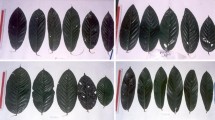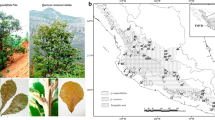Abstract
Interpreting morphological variability in terms of species delimitation can be challenging. However, correcting species delineation can have strong implications for the sustainable management of exploited species. Up to now, species delimitation between two putative timber species from African forests, Entandrophragma congoense and E. angolense, remained unclear. To investigate their differences, we applied an integrated approach which combines morphological traits and genetic markers. We defined 13 morphological characters from 81 herbarium specimens and developed 15 new polymorphic microsatellite markers to genotype 305 samples (herbarium samples and specimens collected in the field across the species distribution ranges). Principal component analysis (PCA) of morphological data and the Bayesian clustering analyses of genetic data were used to assess differentiation between putative species. These analyses support two well-differentiated groups (FST = 0.30) occurring locally in sympatry. Moreover, these two groups present distinct morphological characters at the level of the trunk, leaflets, and seeds. Our genetic markers identified few individuals (4%) that seem to be hybrids, though there is no evidence of genetic introgression from geographic patterns of genetic variation. Hence, our results provide clear support to recognize E. congoense as a species distinct from E. angolense, with a much lower genetic diversity than the latter, and that should be managed accordingly. This work highlights the power of microsatellite markers in resolving species boundaries.





Similar content being viewed by others
References
African Plant Database - version 3.4.0 (2018). Conservatoire et Jardin botaniques de la Ville de Genève and South African National Biodiversity Institute, Pretoria. Retrieved June 2018, from <http://www.ville-ge.ch/musinfo/bd/cjb/africa/>
Anderson EC, Thompson EA (2002) A model-based method for identifying species hybrids using multilocus genetic data. Genetics 160:1217–1229 http://www.ville-ge.ch/musinfo/bd/cjb/africa
Chessel D, Dufour AB, Thioulouse J et al (2004) The ade4 package-I-One-table methods. R news 4:5–10
Chevalier A (1909) Les végétaux utiles de l’Afrique tropicale française: études scientifiques et agronomiques. Dépot des publications
Chybicki IJ, Burczyk J (2009) Simultaneous estimation of null alleles and inbreeding coefficients. J Hered 100:106–113. https://doi.org/10.1093/jhered/esn088
Culley TM, Weller SG, Sakai AK, Putnam KA (2008) Characterization of microsatellite loci in the Hawaiian endemic shrub Schiedea adamantis (Caryophyllaceae) and amplification in related species and genera. Mol Ecol Resour 8:1081–1084
Dainou K, Blanc-Jolivet C, Degen B, Kimani P, Ndiade-Bourobou D, Donkpegan AS, Tosso F, Kaymak E, Bourland N, Doucet JL, Hardy OJ (2016) Revealing hidden species diversity in closely related species using nuclear SNPs, SSRs and DNA sequences - a case study in the tree genus Milicia. BMC Evol Biol 16:259. https://doi.org/10.1186/s12862-016-0831-9
Daïnou K, Flot J-F, Degen B, Blanc-Jolivet C, Doucet J-L, Lassois L, Hardy OJ (2017) DNA taxonomy in the timber genus Milicia: evidence of unidirectional introgression in the West African contact zone. Tree Genet Genomes 13:90. https://doi.org/10.1007/s11295-017-1174-4
Dayrat B (2005) Towards integrative taxonomy. Biol J Linn Soc 85:407–415
de Candolle C (1894) Meliaceae novae. 2. Asiaticae et Africanae. Bull Herb Boissier 2:577–584
De Queiroz K (2007) Species concepts and species delimitation. Syst Biol 56:879–886
de Wilde JJFE (2015) Meliaceae. In: Sosef MSM, Florence J, Ngok BL, Bourobou BHP (eds) Flore du Gabon, vol 47. Margraf Publishers, Wekersheim, pp 5–74
Doyle JJ, Doyle JL (1987) CTAB DNA extraction in plants. Phytochem Bull 19:11–15
Dray S, Dufour AB (2007) The ade4 package: implementing the duality diagram for ecologists. J Stat Softw 22:1–20
Duminil J, Di Michele M (2009) Plant species delimitation: a comparison of morphological and molecular markers. Plant Biosyst 143:528–542
Duminil J, Kenfack D, Viscosi V, Grumiau L, Hardy OJ (2012) Testing species delimitation in sympatric species complexes: the case of an African tropical tree, Carapa spp.(Meliaceae). Mol Phylogenet Evol 62:275–285
Earl DA, VonHoldt BM, von Reumont B (2012) STRUCTURE HARVESTER: a website and program for visualizing STRUCTURE output and implementing the Evanno method. Conserv Genet Resour 4:359–361. https://doi.org/10.1007/s12686-011-9548-7
Edwards DL, Knowles LL (2014) Species detection and individual assignment in species delimitation: can integrative data increase efficacy? Proceedings Biol Sci 281:20132765. https://doi.org/10.1098/rspb.2013.2765
Evanno G, Regnaut S, Goudet J (2005) Detecting the number of clusters of individuals using the software structure: a simulation study. Mol Ecol 14:2611–2620. https://doi.org/10.1111/j.1365-294X.2005.02553.x
Hardy OJ, Vekemans X (2001) Patterns of allozyme variation in diploid and tetraploid Centaurea jacea at different spatial scales. Evolution 55:943–954
Hardy OJ, Vekemans X (2002) SPAGeDi: a versatile computer program to analyse spatial genetic structure at the individual or population levels. Mol Ecol Notes 2:618–620
Hardy OJ, Charbonnel N, Fréville H, Heuertz M (2003) Microsatellite allele sizes: a simple test to assess their significance on genetic differentiation. Genetics 163:1467–1482
Haselhorst M, Buerkle C (2011) Detection of hybrids in natural populations of Picea glauca and Picea englemannii. Univ Wyoming Natl Park Serv Res Cent Annu Rep 33
Ikabanga DUDU, Stévart T, Koffi KGG, Monthé FK, Doubindou ECN, Dauby G, Souza A, M’BATCHI B, Hardy O (2017) Combining morphology and population genetic analysis uncover species delimitation in the widespread African tree genus Santiria (Burseraceae). Phytotaxa 321:166–180. https://doi.org/10.11646/phytotaxa.321.2.2
Janzen DH, Burns JM, Cong Q, Hallwachs W, Dapkey T, Manjunath R, Hajibabaei M, Hebert PDN, Grishin NV (2017) Nuclear genomes distinguish cryptic species suggested by their DNA barcodes and ecology. Proc Natl Acad Sci U S A 114:8313–8318. https://doi.org/10.1073/pnas.1621504114
Kasongo-Yakusu E, Monthe FK, Nils B, Hardy OJ, Louppe D, Lokanda FBM, Hubau W, Kahindo J-MM, Van Den Bulcke J, Van Acker J, Beeckman H (2018) Le genre Entandrophragma (Meliaceae): taxonomie et écologie d’arbres africains d’intérêt économique (synthèse bibliographique). Biotechnol Agron société Environ 22:1–15
Kearse M, Moir R, Wilson A, Stones-Havas S, Cheung M, Sturrock S, Buxton S, Cooper A, Markowitz S, Duran C, Thierer T, Ashton B, Meintjes P, Drummond A (2012) Geneious Basic: an integrated and extendable desktop software platform for the organization and analysis of sequence data. Bioinformatics 28:1647–1649. https://doi.org/10.1093/bioinformatics/bts199
Klopper RR, Chatelain C, Habashi C, Gautier L, Spichiger R-E (2006) Checklist of the flowering plants of sub-Saharan Africa: an index of accepted names and synonyms. Sabonet
Le Guyader H (2002) Doit-on abandonner le concept d’espèce? Le Courr l’environnement l’INRA 51–64
Ley A, Hardy O (2010) Species delimitation in the Central African herbs Haumania (Marantaceae) using georeferenced nuclear and chloroplastic DNA sequences. Mol Phylogenet Evol. https://doi.org/10.1016/j.ympev.2010.08.027
Ley AC, Hardy OJ (2017) Hybridization and asymmetric introgression after secondary contact in two tropical African climber species, Haumania danckelmaniana and Haumania liebrechtsiana (Marantaceae). Int J Plant Sci 178:421–430. https://doi.org/10.1086/691628
Liben L (1970) La répartition géographique d’Entandrophragma congoënse (De Wild.) A. Chev.(Meliaceae). Bull du Jard Bot Natl Belgique/Bulletin van Natl Plantentuin van Belgie 299–300
Liben L, Dechamps R (1966) Entandrophragma congoense (De Wild.) A. Chev. espèce méconnue du Congo. Bull du Jard Bot l’Etat, Bruxelles/Bulletin van den Rijksplantentuin, Brussel 415–424
Mayr E (1992) Species concepts and their application. Units Evol MIT 15–25
Mayr E (1942) Systematics and the origin of species, from the viewpoint of a zoologist. Harvard University Press
Meunier Q, Moumbogou C, Doucet J-L (2015) Les arbres utiles du Gabon. Presses Agronomiques de Gembloux
Micheneau C, Dauby G, Bourland N, Doucet JL, Hardy OJ (2011) Development and characterization of microsatellite loci in Pericopsis elata (Fabaceae) using a cost-efficient approach. Am J Bot 98:e268–e270. https://doi.org/10.3732/ajb.1100070
Monthe F, Duminil J, Tosso F, Migliore J, Hardy OJ (2017) Characterization of microsatellite markers in two exploited African trees, Entandrophragma candollei and E. utile (Meliaceae). Appl Plant Sci 5:1600130. https://doi.org/10.3732/apps.1600130
Peakall R, Smouse PE (2012) GenALEx 6.5: genetic analysis in excel. Population genetic software for teaching and research-an update. Bioinformatics 28:2537–2539. https://doi.org/10.1093/bioinformatics/bts460
Poorter L (1999) Growth responses of 15 rain-forest tree species to a light gradient: the relative importance of morphological and physiological traits. Funct Ecol 13:396–410. https://doi.org/10.1046/j.1365-2435.1999.00332.x
Pritchard JK, Stephens M, Donnelly P (2000) Inference of population structure using multilocus genotype data. Genetics 155(2):945–959
Schlick-Steiner BC, Steiner FM, Seifert B, Stauffer C, Christian E, Crozier RH (2010) Integrative taxonomy: a multisource approach to exploring biodiversity. Annu Rev Entomol 55:421–438
Slik JWF, Arroyo-Rodríguez V, Aiba S-I, Alvarez-Loayza P, Alves LF, Ashton P, Balvanera P, Bastian ML, Bellingham PJ, van den Berg E, Bernacci L, da Conceição BP, Blanc L, Böhning-Gaese K, Boeckx P, Bongers F, Boyle B, Bradford M, Brearley FQ et al (2015) An estimate of the number of tropical tree species. Proc Natl Acad Sci U S A 112:7472–7477. https://doi.org/10.1073/pnas.1423147112
Sosef MSM, Dauby G, Blach-Overgaard A, van der Burgt X, Catarino L, Damen T, Deblauwe V, Dessein S, Dransfield J, Droissart V, Duarte MC, Engledow H, Fadeur G, Figueira R, Gereau RE, Hardy OJ, Harris DJ, de Heij J, Janssens S, Klomberg Y, Ley AC, Mackinder BA, Meerts P, van de Poel JL, Sonké B, Stévart T, Stoffelen P, Svenning J-C, Sepulchre P, Zaiss R, Wieringa JJ, Couvreur TLP (2017) Exploring the floristic diversity of tropical Africa. BMC Biol 15:15. https://doi.org/10.1186/s12915-017-0356-8
Sprague TA (1910) Entandrophragma, Leioptyx and Pseudocedrela. Bull Misc Inf (Royal Gard Kew) 1910:177–182
Staner P (1941) Les Méliacées du Congo Belge. Bull du Jard Bot l’Etat, Bruxelles/Bulletin van den Rijksplantentuin, Brussel 16:109–251
Tarasjev A, Barisić Klisarić N, Stojković B, Avramov S (2009) Phenotypic plasticity and between population differentiation in Iris pumila transplants between native open and anthropogenic shade habitats. Genetika 45:1078–1086
The Plant List (2013) Version 1.1. Retrieved June 2018, from http://www.theplantlist.org/
Tosso F, Dainou K, Hardy OJ, Sinsin B, Doucet J-L (2015) Le genre Guibourtia Benn., un taxon à haute valeur commerciale et sociétale (synthèse bibliographique). Biotechnol Agron société Environ 19:71–88
Weber AA-T, Stöhr S, Chenuil A (2017) Species delimitation in the presence of strong incomplete lineage sorting and hybridization. bioRxiv. https://doi.org/10.1101/240218
Acknowledgments
We are grateful to Meise Botanic Garden (Belgium), the Herbarium and African Botanical Library (BRLU) of Université Libre de Bruxelles (ULB), and Naturalis Biodiversity Center (Leiden, the Netherlands), for making the herbarium specimens available. We thank the forest company PALLISCO, especially Bienvenue Ango for its support to field sampling. We are also grateful to the DynAfFor and P3FAC projects, funded by the Fonds Français pour l’Environnement Mondial, which facilitated access to the field, and to two anonymous referees for their comments.
Data archiving statement
The microsatellite markers are submitted to GenBank (Table 3).
Funding
We thank the Fonds pour la Formation à la Recherche dans l’Industrie et l’Agriculture (FRIA-FNRS, Belgium) through a PhD grant to the first author, the Fonds de la Recherche Scientifique (FRS-FNRS) through grant X.3040.17, and the Belgian Science Policy (Belspo) for funding the project AFRIFORD.
Author information
Authors and Affiliations
Corresponding author
Additional information
Communicated by Y. Tsumura
Compliance with ethical standards
ESM 1
(DOCX 852 kb)
Rights and permissions
About this article
Cite this article
Monthe, F.K., Duminil, J., Kasongo Yakusu, E. et al. The African timber tree Entandrophragma congoense (Pierre ex De Wild.) A.Chev. is morphologically and genetically distinct from Entandrophragma angolense (Welw.) C.DC. Tree Genetics & Genomes 14, 66 (2018). https://doi.org/10.1007/s11295-018-1277-6
Received:
Revised:
Accepted:
Published:
DOI: https://doi.org/10.1007/s11295-018-1277-6




